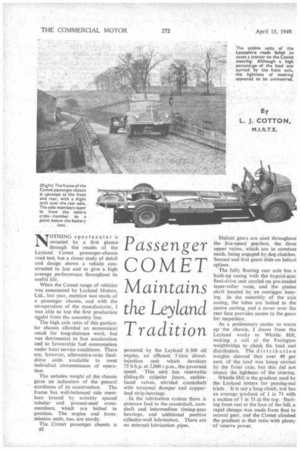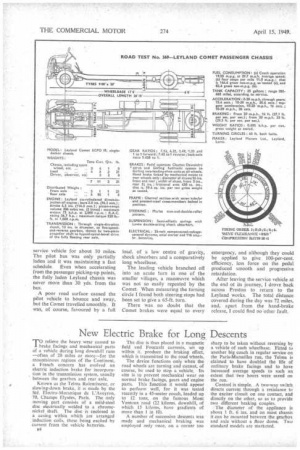Passenger COMET Maintains the Leyland Tradition
Page 10

Page 11

Page 12

If you've noticed an error in this article please click here to report it so we can fix it.
By L. J. COTTON, m.I.R.T.E.
NOTHING spectacular is revealed by a first glance through the results of the Leyland Comet passenger-chassis road test, but a closer study of detail and design shows a vehicle constructed to last and to give a high average performance throughout its useful life.
When the Comet range of vehicles was announced by Leyland Motors, Ltd., last year, mention was made of a passenger chassis, and with the co-operation of the manufacturer, was able to test the first production nlodel from the assembly line.
The high axle ratio of this particular chassis afforded an economical result far long-distance work, but was detrimental to fast acceleration and to favourable fuel consumption under local service conditions. There are, however, alternative-ratio finaldrive units available to meet individual circumstances of operation.
The unladen weight of the chassis gives an indication of the general sturdiness of its construction. The frame has well-balanced side members braced by suitably spaced tubular and pressed-steel crossmembers, which are bolted in 'position. The engine and transmission units, too, are sturdy.
The Comet passenger chassis is B2
powered by the Leyland 0.300 oil engine, an efficient 5-litre directinjection unit which develops 75 .b.h.p. at 2,000 r.p.m., the governed speed. This unit has renewable sliding-fit cylinder liners, stellitefaced valves, nitrided crankshaft with torsional damper and copperlead strip-bearings.
In the lubrication system there is pressure feed to the crankshaft, camshaft and intermediate timing-gear bearings, and additional positive cylinder-wall lubrication. There are no externallubrication pipes. Helical gears are used throughout the five-speed gearbox, the three upper ratios, which are in constant mesh, being engaged by dog clutches. Second and first gears slide on helical splines.
The fully floating rear axle has a built-up casing with the hypoid-gear final-drive unit carried on pre-loaded taper-roller races, and the pinion shaft located by an outrigger bearing. In the assembly of the axle casing, the tubes are bolted to the centre casting, and a cover over the rear face provides access to the gears for inspection.
As a preliminary canter to warm up the chassis, I drove from the Leyland works to Whittle Hill, making a call at the Farington weighbridge to check the load and distribution. The distribution weights showed that over 40 per cent. of the load was being carried by the front axle, but this did not impair the lightness of the steering. . Whittle Hill is the gradient used by the Leyland testers for passing-out trials. It is not a long climb, but has an average gradient of 1 in 71 with a section of 1 in 51 at the top. Starting from rest at the foot of the hill, a rapid change was made from first to second gear, and the Comet climbed the gradient M that ratio with plenty of -reserve power.
A stop-start test was attempted on the severest section, and the hand brake was applied while engaging bottom gear. Although the parking brake held the chassis, it was not without some difficulty that I managed to depress the release knob to move the lever to the " off " position. Although it may not look so attractive, I prefer to use the trigger release mechanism that is fitted to the Comet goods chassis.
As the chassis appeared to have reached normal operating temperatures, the acceleration and braking trials were attempted on a stretch of road at the foot of the climb. The times recorded on the initial tests proved that there was a slight gradient, and because of the high gearing of the chassis, I decided to continue the tests on the Preston-Southport road, which has a level surface and is relatively free from traffic.
The constant-mesh gears, together with the power given by the long selector lever, provided• scope for "
snappy" changes. Starting in second gear, it took 30.6 secs. to reach 30 m.p.h. from a standing start. In top gear,.. 30 m.p.h. was reached consistently from 10 m.p.h. in 36 sees, Doubtless a lower axle
ratio would have given better results.
The dry concrete road was admirable for the brake trials, because with the efficient system of the Comet the wheels would probably have locked on a smoother surface. With an emergency brake application • the chassis was brought to a standstill from 30 m.p.h. in 33 ft., which
corresponds to an efficiency of 90 per cent. Repeat tests proved this to be an average result.
"The Commercial Motor" , test tank was fitted to measure the 'fuel used during the consumption trials. With a full tank, and stop watches in action, I started the 12-mile outand-return course, which, with only two stops, was representative of normal conditions of long-distance operation. On this occasion the high axle ratio proved to be an advantage, and, observing a maximum speed of 33 m.p.h., the consumption equivalent for the course was 19 m.p.g.
Such an economical result needed verifying, so a repeat test was made under identical conditions. This yielded a confirmatory figure of 19.1 m.p.g. at an average speed of 29.7 m.p.h.
When testing the chassis as a stage carriage, with . four stops to every mile, there was barely time to get into top gear before braking for the next stop. Despite this drastic treatment, the fuel return was 11 m.p.g., at an average speed of 17 m.p.h. A more economical result would have been obtained had the lower axle ratio of 6 1/6 to 1 been employed.
No Heat Loss Engine-oil and radiator-top-tank temperatures were taken at the start and finish of the stage service test, and with atmosphere at 55. degrees F. the water temperature rose by 5 degrees to reach a maximum of 153 degrees F. at the end of the course. The engine-oil temperature remained constant at 85 degrees F. It would appear that the heat generated in the Comet engine is put to a useful purpose and remarkably little energy is wasted.
When testing a passenger model as a chassis, it is irripossible to say definitely how much engine noise or vibration will be detected inside the body, but with the Leyland togglelink suspension of the power unit there was little oscillation to be felt on the frame once the engine had warmed up to normal operating conditions.
As the Comet is a semi-forwardcontrol model, part of the engine and cowling projects into the driver's compartment. The noise and heat insulation afforded by the bonnet cover appeared to be good—as far as it could be judged on an open chassis.
To test the Comet under, urban service conditions, I followed a
service vehicle for about 10 miles. The pilot bus was only partially laden and it was maintaining a fast schedule. Even when accelerating from the passenger picking-up points, the fully laden Leyland chassis was never more than 30 yds. from the bus.
A poor road surface caused the pilot vehicle to bounce and sway, but the Comet travelled smoothly. It was, of course, favoured by a full load, of a low centre of gravity, shock absorbers and a comparatively long wheelbase.
The leading vehicle branched of into an acute turn in one of the smaller villages, a manceuvre which was not so easily repeated by the Comet. When measuring the turning circle I found both steering stops had been set to give a 65-ft. turn.
There was no doubt that the Comet brakes were equal to every emergency, and although they could be applied to give 100-per-cent. efficiency, less force on the pedal produced smooth and progressive retardation.
After leaving the service vehicle at the end of its journey, I drove back across Preston to return to the Leyland works. The total distance covered during the day was 72 miles, and, apart from the hand-brake release, I could find no other fault.


























